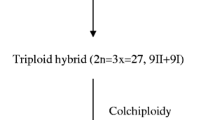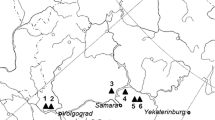Abstract
Luzula campestris, L. pallidula and tetraploi plants of this section from Ireland were studied electrophoretically. A hypothesis of alloploid origin for the Irish tetraploids from a hybrid betweenL. campestris andL. pallidula, based on the morphology, and karyology of the relevant taxa, has been tested. The presumed parental taxa are divergent in several loci,L. pallidula being highly homozygous andL. campestris moderately heterozygous. The Irish tetraploid combines the alleles of the putative parents, has no unique alleles, and exhibits a high frequency of heterozygotes, inAdh-2 andGpi-1, with invariably additive patterns. The Irish tetraploid has a low genotype diversity. The allozyme data support the hypothesis of alloploid origin for the Irish tetraploid withL. campestris andL. pallidula as possible parents.
Similar content being viewed by others
References
Buchanan J. (1960):Luzula campestris (L.) DC. Proc. Linn. Soc. London 171: 126–128.
Crawford D.J. (1989): Enzyme electrophoresis and plant systematics.—In:Soltis D.E. & Soltis P.E.: Isozymes in plant biology, Dioscorides Press, Portland, pp. 146–164.
Jarolímová V. & Kirschner J. (1995): Tetraploids inLuzula multiflora (Juncaceae) in Ireland: Karyology and meiotic behaviour.—Folia Geobot. Phytotax. (in press).
Kirschner J. (1991): An account of natural hybridization withinLuzula sect.Luzula (Juncaceae) in Europe. Preslia 63: 81–112.
Kirschner J. (1992): Karyological differentiation ofLuzula in Europe.—Thaiszia J. Bot. 2:11–39.
Kirschner J (1993): Taxonomic survey ofLuzula sect.Juncaceae) in Ireland with special reference toLuzula pallidulaKirschner. Irish Naturalists' J. 24: 297–298.
Nordenskiöld H. (1956): Cyto-taxonomical studies in the genusLuzula II. Hybridization experiments in thecampestris-multiflora complex. Hereditas 42: 7–73.
Shaw C. R. &Prasad R. (1970): Starch gel electrophoresis of enzymes-a compilation of recipes. Biochem. Genet. 4:297–320.
Vallejos C.E. (1983): Enzyme activity staining.—In:Tankseley S.D. & Orton T.J.: Isozymes in plant genetics and breeding, Part A, Elsevier, Amsterdam, pp. 469–516.
Weeden N.F. &Wendel J.F. (1989): Visualization and interpretation of plant isozymes.—In:Soltis D.E. & Soltis P.S.: Isozymes in plant biology, Dioscorides Press, Portland, pp. 46–72.
Author information
Authors and Affiliations
Corresponding author
Rights and permissions
About this article
Cite this article
Kirschner, J. Allozyme analysis ofLuzula sect.Luzula (Juncaceae) in Ireland: Evidence of the origin of tetraploids. Folia Geobot 30, 283–290 (1995). https://doi.org/10.1007/BF02803711
Received:
Revised:
Accepted:
Issue Date:
DOI: https://doi.org/10.1007/BF02803711




